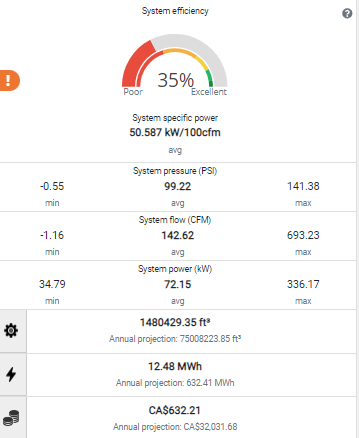Compressed air systems classed as “best practices” have permanent monitoring systems installed that can automatically track the performance of the system. In this way, problems can be easily detected and dealt with quickly. Important variables like pressure, power, flow, temperature, and dew point are measured and sent to a central database, to be stored for easy troubleshooting and later analysis. Using this information, the system can be easily managed, and the system costs calculated for the information of the operators and management.

The system shown in the graphic had no such monitoring system. It was installed on a temporary basis for a brief compressed air system audit. Plant management was surprised to learn that this system was consuming more than double the power it should — and was costing $16,000 more to operate than an optimized system. We know that “information is power,” and to obtain this data, we need to carefully measure!
Management was also surprised to learn that the air compressor in question, a single stage lubricated screw compressor, was running in a very poor operating mode called modulation. They had no idea what modulation was and were curious. When observing the compressor in the compressor room, it sounded just fine, but once key indicators were measured, the problem became obvious.
And because system operators had a lack of training in compressed air optimization, they were unaware that they could have easily saved thousands of dollars of operating costs by switching the compressor to a more efficient load/unload mode. This could be done by a push of a button in this case — and by better adjusting the compressor’s operating pressure band.
Over the years, the price of the needed instrumentation to efficiently measure and record data for compressed air systems has become more and more affordable. And good training is available to help plant operators interpret the data. We suggest that you consider measuring your system to see if you have any hidden surprises lurking in your data.
More information and training about compressed air systems can be found here:
Compressed Air Challenge
Compressed Air & Gas Institute
Filed Under: Components Oil Coolers, Compressed Air Technologies, Pneumatic Tips, Technologies